FEATURES
Low offset voltage: 1 μV
Input offset drift: 0.005 μV/°C
Rail-to-rail input and output swing
5 V/2.7 V single-supply operation
High gain: 145 dB typical
CMRR: 140 dB typical
PSRR: 130 dB typical
Ultralow input bias current: 10 pA typical
Low supply current: 750 μA per op amp
Overload recovery time: 50 μs
No external capacitors required
APPLICATIONS
Temperature sensors
Pressure sensors
Precision current sensing
Strain gage amplifiers
Medical instrumentation
Thermocouple amplifiers
GENERAL DESCRIPTION
This family of amplifiers has ultralow offset, drift, and bias
current. The AD8571, AD8572, and AD8574 are single, dual,
and quad amplifiers, respectively, featuring rail-to-rail input
and output swings. All are guaranteed to operate from 2.7 V to
5 V single supply.
The AD857x family provides benefits previously found only in
expensive auto-zeroing or chopper-stabilized amplifiers. Using
Analog Devices, Inc., topology, these zero-drift amplifiers
combine low cost with high accuracy. (No external capacitors
are required.) Using a patented spread-spectrum, auto-zero
technique, the AD857x family eliminates the intermodulation
effects from interaction of the chopping function with the
signal frequency in ac applications.
With an offset voltage of only 1 μV and drift of 0.005 μV/°C, the
AD857x family is perfectly suited for applications where error
sources cannot be tolerated. Position and pressure sensors,
medical equipment, and strain gage amplifiers benefit greatly
from nearly zero drift over their operating temperature range.
Many more systems require the rail-to-rail input and output
swings provided by the AD857x family.
Zero-Drift, Single-Supply, Rail-to-Rail
Input/Output Operational Amplifiers
AD8571/AD8572/AD8574
PIN CONFIGURATIONS
NC
–IN A
+IN A
V–
1
2
3
4
AD8571
TOP VIEW
(Not to Scale)
8
7
6
5
NC
V+
OUT A
NC
NC = NO CONNECT
1
0
0
-
4
0
1
1
0
Figure 1. 8-Lead MSOP (RM Suffix)
NC 1
–IN A 2
+IN A 3
V– 4
AD8571
TOP VIEW
(Not to Scale)
8
7
6
5
NC
V+
OUT A
NC
NC = NO CONNECT
4
0
0
-
4
0
1
1
0
Figure 2. 8-Lead SOIC (R Suffix)
OUT A
–IN A
+IN A
V–
1
2
3
4
AD8572
TOP VIEW
(Not to Scale)
8
7
6
5
V+
OUT B
–IN B
+IN B
2
0
0
-
4
0
1
1
0
Figure 3. 8-Lead TSSOP (RU Suffix)
OUT A
–IN A
+IN A
V–
1
2
3
4
AD8572
TOP VIEW
(Not to Scale)
8
7
6
5
V+
OUT B
–IN B
+IN B
5
0
0
-
4
0
1
1
0
Figure 4. 8-Lead SOIC (R Suffix)
OUT A 1
–IN A 2
+IN A 3
V+ 4
+IN B 5
–IN B 6
OUT B 7
AD8574
TOP VIEW
(Not to Scale)
14
13
12
11
10
9
8
OUT D
–IN D
+IN D
V–
+IN C
–IN C
OUT C
3
0
0
-
4
0
1
1
0
Figure 5. 14-Lead TSSOP (RU Suffix)
OUT A 1
–IN A 2
+IN A 3
V+ 4
+IN B 5
–IN B 6
OUT B 7
AD8574
TOP VIEW
(Not to Scale)
14
13
12
11
10
9
8
OUT D
–IN D
+IN D
V–
+IN C
–IN C
OUT C
6
0
0
-
4
0
1
1
0
Figure 6. 14-Lead SOIC (R Suffix)
The AD857x family is specified for the extended industrial/
automotive temperature range (−40°C to +125°C). The AD8571
single amplifier is available in 8-lead MSOP and narrow SOIC
packages. The AD8572 dual amplifier is available in 8-lead narrow
SOIC and surface-mount TSSOP packages. The AD8574 quad
amplifier is available in 14-lead narrow SOIC and TSSOP packages.
Rev. E
Information furnished by Analog Devices is believed to be accurate and reliable. However, no
responsibility is assumed by Analog Devices for its use, nor for any infringements of patents or other
rights of third parties that may result from its use. Specifications subject to change without notice. No
license is granted by implication or otherwise under any patent or patent rights of Analog Devices.
Trademarks and registered trademarks are the property of their respective owners.
One Technology Way, P.O. Box 9106, Norwood, MA 02062-9106, U.S.A.
www.analog.com
Tel: 781.329.4700
Fax: 781.461.3113 ©1999–2011 Analog Devices, Inc. All rights reserved.
�
AD8571/AD8572/AD8574
TABLE OF CONTENTS
Features .............................................................................................. 1
Applications....................................................................................... 1
General Description......................................................................... 1
Pin Configurations ........................................................................... 1
Revision History ............................................................................... 2
Specifications..................................................................................... 3
5 V Electrical Characteristics...................................................... 3
2.7 V Electrical Characteristics................................................... 4
Absolute Maximum Ratings............................................................ 5
Thermal Characteristics .............................................................. 5
ESD Caution.................................................................................. 5
Typical Performance Characteristics ............................................. 6
Functional Description.................................................................. 14
Amplifier Architecture .............................................................. 14
Basic Auto-Zero Amplifier Theory.......................................... 14
Auto-Zero Phase......................................................................... 15
Amplification Phase................................................................... 15
High Gain, CMRR, and PSRR .................................................. 16
REVISION HISTORY
2/11—Rev. D to Rev. E
Changes to Figure 66...................................................................... 21
Updated Outline Dimensions....................................................... 22
Changes to Ordering Guide .......................................................... 23
6/08—Rev. C to Rev. D
Changes to Figure 19 and Figure 20............................................... 8
Changes to Figure 44...................................................................... 12
Changes to Figure 38...................................................................... 13
Moved Figure 50 and Figure 51 .................................................... 14
Changes to Figure 66, Precision Current Meter Section, Layout,
Figure 67, Equation 24, and Figure 68......................................... 21
5/07—Rev. B to Rev. C
Changes to Features.......................................................................... 1
Changes to Table 1............................................................................ 3
Changes to Table 2............................................................................ 4
Changes to Basic Auto-Zero Amplifier Theory Section ........... 14
Changes to Figure 50...................................................................... 15
Changes to Figure 55...................................................................... 16
Changes to Figure 66...................................................................... 21
Updated Outline Dimensions....................................................... 22
Maximizing Performance Through Proper Layout............... 16
1/f Noise Characteristics ........................................................... 17
Random Auto-Zero Correction Eliminates Intermodulation
Distortion .................................................................................... 17
Broadband and External Resistor Noise Considerations.......... 18
Output Overdrive Recovery...................................................... 18
Input Overvoltage Protection................................................... 18
Output Phase Reversal............................................................... 18
Capacitive Load Drive ............................................................... 19
Power-Up Behavior.................................................................... 19
Applications Information .............................................................. 20
5 V Precision Strain Gage Circuit ............................................ 20
3 V Instrumentation Amplifier ................................................ 20
High Accuracy Thermocouple Amplifier............................... 21
Precision Current Meter............................................................ 21
Precision Voltage Comparator.................................................. 21
Outline Dimensions....................................................................... 22
Ordering Guide .......................................................................... 23
9/06—Rev. A to Rev. B
Updated Format..................................................................Universal
Changes to Table 1.............................................................................3
Changes to Table 2.............................................................................4
Changes to Figure 50...................................................................... 14
Changes to Figure 51...................................................................... 15
Changes to Figure 66...................................................................... 21
Deleted Figure 69 and SPICE Macro-Model Section ................ 17
Deleted SPICE Macro-Model for the AD857x Section............. 18
Updated Outline Dimensions....................................................... 22
Changes to Ordering Guide.......................................................... 23
7/03—Rev. 0 to Rev. A
Renumbered Figures..........................................................Universal
Changes to Ordering Guide.............................................................4
Change to Figure 15. ...................................................................... 16
Updated Outline Dimensions....................................................... 19
10/99—Revision 0: Initial Version
Rev. E | Page 2 of 24
�
AD8571/AD8572/AD8574
SPECIFICATIONS
5 V ELECTRICAL CHARACTERISTICS
VS = 5 V, VCM = 2.5 V, VO = 2.5 V, TA = 25°C, unless otherwise noted.
Table 1.
Parameter
INPUT CHARACTERISTICS
Min
0
120
115
125
120
4.99
4.99
4.95
4.95
±25
120
115
Typ
1
10
1.0
160
2.5
20
150
30
150
140
130
145
135
0.005
4.998
4.997
4.98
4.975
1
2
10
15
±50
±40
±30
±15
130
130
850
1000
0.4
0.05
1.5
1.3
0.41
51
2
Max
5
10
50
1.5
300
4
70
200
150
400
5
0.04
10
10
30
30
975
1075
0.3
Unit
μV
μV
pA
nA
pA
nA
pA
pA
pA
pA
V
dB
dB
dB
dB
μV/°C
V
V
V
V
mV
mV
mV
mV
mA
mA
mA
mA
dB
dB
μA
μA
V/μs
ms
MHz
μV p-p
μV p-p
nV/√Hz
fA/√Hz
Offset Voltage
Input Bias Current
AD8571/AD8574
AD8572
Input Offset Current
AD8571/AD8574
AD8572
Input Voltage Range
Common-Mode Rejection Ratio
Large Signal Voltage Gain1 A
Offset Voltage Drift
OUTPUT CHARACTERISTICS
Output Voltage High
Output Voltage Low
Short-Circuit Limit
Output Current
POWER SUPPLY
Power Supply Rejection Ratio
Supply Current per Amplifier
DYNAMIC PERFORMANCE
Slew Rate
Overload Recovery Time
Gain Bandwidth Product
NOISE PERFORMANCE
Voltage Noise
Voltage Noise Density
Current Noise Density
1 Gain testing is dependent upon test bandwidth.
Symbol
VOS
IB
IOS
CMRR
VO R
∆VOS/∆T
VOH R
VOL R
ISC
IO
PSRR
ISY V
SR
GBP
en p-p
en
in
Conditions
−40°C ≤ TA ≤ +125°C
−40°C ≤ TA ≤ +125°C
−40°C ≤ TA ≤ +85°C
−40°C ≤ TA ≤ +125°C
−40°C ≤ TA ≤ +125°C
−40°C ≤ TA ≤ +85°C
−40°C ≤ TA ≤ +125°C
VCM = 0 V to 5 V
−40°C ≤ TA ≤ +125°C
L = 10 kΩ, VO = 0.3 V to 4.7 V
−40°C ≤ TA ≤ +125°C
−40°C ≤ TA ≤ +125°C
L = 100 kΩ to GND
RL = 100 kΩ to GND @ −40°C to +125°C
RL = 10 kΩ to GND
RL = 10 kΩ to GND @ −40°C to +125°C
L = 100 kΩ to V+
RL = 100 kΩ to V+ @ −40°C to +125°C
RL = 10 kΩ to V+
RL = 10 kΩ to V+ @ −40°C to +125°C
−40°C to +125°C
−40°C to +125°C
VS = 2.7 V to 5.5 V
−40°C ≤ TA ≤ +125°C
O = 0 V
−40°C ≤ TA ≤ +125°C
RL = 10 kΩ
0 Hz to 10 Hz
0 Hz to 1 Hz
f = 1 kHz
f = 10 Hz
Rev. E | Page 3 of 24
�
AD8571/AD8572/AD8574
2.7 V ELECTRICAL CHARACTERISTICS
VS = 2.7 V, VCM = 1.35 V, VO = 1.35 V, TA = 25°C, unless otherwise noted.
Table 2.
Parameter
INPUT CHARACTERISTICS
Offset Voltage
Input Bias Current
AD8571/AD8574
AD8572
Input Offset Current
AD8571/AD8574
AD8572
Input Voltage Range
Common-Mode Rejection Ratio
Large Signal Voltage Gain1 A
Offset Voltage Drift
OUTPUT CHARACTERISTICS
Output Voltage High
Output Voltage Low
Short-Circuit Limit
Output Current
POWER SUPPLY
Power Supply Rejection Ratio
Supply Current per Amplifier
DYNAMIC PERFORMANCE
Slew Rate
Overload Recovery Time
Gain Bandwidth Product
NOISE PERFORMANCE
Voltage Noise
Voltage Noise Density
Current Noise Density
1 Gain testing is dependent upon test bandwidth.
Symbol
VOS
IB
IOS
CMRR
VO R
∆VOS/∆T
VOH R
VOL R
ISC
IO
PSRR
ISY V
SR
GBP
en p-p
en
in
Conditions
−40°C ≤ TA ≤ +125°C
−40°C ≤ TA ≤ +125°C
−40°C ≤ TA ≤ +85°C
−40°C ≤ TA ≤ +125°C
−40°C ≤ TA ≤ +125°C
−40°C ≤ TA ≤ +85°C
−40°C ≤ TA ≤ +125°C
VCM = 0 V to 2.7 V
−40°C ≤ TA ≤ +125°C
L = 10 kΩ, VO = 0.3 V to 2.4 V
−40°C ≤ TA ≤ +125°C
−40°C ≤ TA ≤ +125°C
L = 100 kΩ to GND
RL = 100 kΩ to GND @ −40°C to +125°C
RL = 10 kΩ to GND
RL = 10 kΩ to GND @ −40°C to +125°C
L = 100 kΩ to V+
RL = 100 kΩ to V+ @ −40°C to +125°C
RL = 10 kΩ to V+
RL = 10 kΩ to V+ @ −40°C to +125°C
−40°C to +125°C
−40°C to +125°C
VS = 2.7 V to 5.5 V
−40°C ≤ TA ≤ +125°C
O = 0 V
−40°C ≤ TA ≤ +125°C
RL = 10 kΩ
0 Hz to 10 Hz
f = 1 kHz
f = 10 Hz
Rev. E | Page 4 of 24
Min
0
115
110
110
105
2.685
2.685
2.67
2.67
±10
120
115
Typ
1
10
1.0
160
2.5
10
150
30
150
130
130
140
130
0.005
2.697
2.696
2.68
2.675
1
2
10
15
±15
±10
±10
±5
130
130
750
950
0.5
0.05
1
2.0
94
2
Max
5
10
50
1.5
300
4
50
200
150
400
2.7
0.04
10
10
20
20
900
1000
Unit
μV
μV
pA
nA
pA
nA
pA
pA
pA
pA
V
dB
dB
dB
dB
μV/°C
V
V
V
V
mV
mV
mV
mV
mA
mA
mA
mA
dB
dB
μA
μA
V/μs
ms
MHz
μV p-p
nV/√Hz
fA/√Hz
�
ABSOLUTE MAXIMUM RATINGS
Table 3.
Parameter
Supply Voltage
Input Voltage
Differential Input Voltage1
ESD (Human Body Model)
Output Short-Circuit Duration to GND
Storage Temperature Range
Operating Temperature Range
Junction Temperature Range
Lead Temperature (Soldering, 60 sec)
1 Differential input voltage is limited to ±5.0 V or the supply voltage,
whichever is less.
Rating
6 V
GND to VS + 0.3 V
±5.0 V
2000 V
Indefinite
−65°C to +150°C
−40°C to +125°C
−65°C to +150°C
300°C
AD8571/AD8572/AD8574
Stresses above those listed under Absolute Maximum Ratings
may cause permanent damage to the device. This is a stress
rating only; functional operation of the device at these or any
other conditions above those indicated in the operational section of
this specification is not implied. Exposure to absolute maximum
rating conditions for extended periods may affect device reliability.
THERMAL CHARACTERISTICS
θJA is specified for the worst-case conditions, that is, θJA is
specified for a device soldered in a circuit board for SOIC and
TSSOP packages.
Table 4. Thermal Resistance
Package Type
8-Lead SOIC (R)
8-Lead MSOP (RM)
8-Lead TSSOP (RU)
14-Lead SOIC (R)
14-Lead TSSOP (RU)
ESD CAUTION
θJA θ
158
190
240
120
180
JC
43
44
43
36
36
Unit
°C/W
°C/W
°C/W
°C/W
°C/W
Rev. E | Page 5 of 24
�
AD8571/AD8572/AD8574
TYPICAL PERFORMANCE CHARACTERISTICS
180
160
140
120
100
80
60
40
20
VS = 2.7V
VCM = 1.35V
TA = 25°C
S
R
E
F
I
I
L
P
M
A
F
O
R
E
B
M
U
N
I
I
S
R
E
F
L
P
M
A
F
O
R
E
B
M
U
N
VS = 5V
VCM = 2.5V
TA = 25°C
180
160
140
120
100
80
60
40
20
0
–2.5
–1.5
–0.5
OFFSET VOLTAGE (µV)
0.5
1.5
2.5
7
0
0
-
4
0
1
1
0
0
–2.5
–1.5
–0.5
OFFSET VOLTAGE (µV)
0.5
1.5
2.5
0
1
0
-
4
0
1
1
0
Figure 7. Input Offset Voltage Distribution
Figure 10. Input Offset Voltage Distribution
50
40
30
20
10
0
–10
–20
–30
0
VS = 5V
TA = –40°C, +25°C, +85°C
+85°C
+25°C
–40°C
1
4
INPUT COMMON-MODE VOLTAGE (V)
2
3
5
8
0
0
-
4
0
1
1
0
Figure 8. Input Bias Current vs. Input Common-Mode Voltage
I
I
S
R
E
F
L
P
M
A
F
O
R
E
B
M
U
N
VS = 5V
TA = 125°C
)
V
m
(
E
G
A
T
L
O
V
T
U
P
T
U
O
)
A
p
(
T
N
E
R
R
U
C
S
A
B
T
U
P
N
I
I
)
A
p
(
T
N
E
R
R
U
C
S
A
B
T
U
P
N
I
I
1500
1000
500
0
–500
–1000
–1500
–2000
0
VS = 5V
VCM = 2.5V
TA = –40°C TO +125°C
0
1
2
3
4
5
INPUT OFFSET DRIFT (nV/°C)
6
1
1
0
-
4
0
1
1
0
Figure 11. Input Offset Voltage Drift Distribution
VS = 5V
TA = 25°C
SOURCE
SINK
12
10
8
6
4
2
0
10k
1k
100
10
1
1
2
3
4
COMMON-MODE VOLTAGE (V)
5
9
0
0
-
4
0
1
1
0
0.1
0.0001
0.001
0.01
1
LOAD CURRENT (mA)
0.1
10
100
2
1
0
-
4
0
1
1
0
Figure 9. Input Bias Current vs. Common-Mode Voltage
Figure 12. Output Voltage to Supply Rail vs. Load Current
Rev. E | Page 6 of 24
�
VS = 2.7V
TA = 25°C
10k
1k
100
10
1
)
V
m
(
E
G
A
T
L
O
V
T
U
P
T
U
O
0.1
0.0001
0.001
AD8571/AD8572/AD8574
TA = 25°C
800
700
600
500
400
300
200
100
)
A
µ
(
I
I
R
E
F
L
P
M
A
R
E
P
T
N
E
R
R
U
C
Y
L
P
P
U
S
SOURCE
SINK
0.01
0.1
1
LOAD CURRENT (mA)
10
100
3
1
0
-
4
0
1
1
0
0
0
1
4
2
SUPPLY VOLTAGE (V)
3
5
6
6
1
0
-
4
0
1
1
0
Figure 13. Output Voltage to Supply Rail vs. Load Current
Figure 16. Supply Current per Amplifier vs. Supply Voltage
)
A
p
(
T
N
E
R
R
U
C
S
A
B
T
U
P
N
I
I
VCM = 2.5V
VS = 5V
1000
750
500
250
0
–75
–50
–25
25
75
0
TEMPERATURE (°C)
50
100
125
150
4
1
0
-
4
0
1
1
0
)
B
d
(
I
N
A
G
P
O
O
L
-
N
E
P
O
VS = 2.7V
CL = 0pF
RL = ∞
60
50
40
30
20
10
0
–10
–20
–30
–40
10k
0
45
90
135
180
225
270
)
s
e
e
r
g
e
D
I
(
T
F
H
S
E
S
A
H
P
100k
1M
10M
100M
FREQUENCY (Hz)
7
1
0
-
4
0
1
1
0
Figure 14. Input Bias Current vs. Temperature
Figure 17. Open-Loop Gain and Phase Shift vs. Frequency
1.0
0.8
0.6
0.4
0.2
)
A
m
(
T
N
E
R
R
U
C
Y
L
P
P
U
S
0
–75
–50
–25
5V
2.7V
100
125
150
5
1
0
-
4
0
1
1
0
25
75
0
TEMPERATURE (°C)
50
)
B
d
(
I
N
A
G
P
O
O
L
-
N
E
P
O
VS = 5V
CL = 0pF
RL = ∞
60
50
40
30
20
10
0
–10
–20
–30
–40
10k
0
45
90
135
180
225
270
)
s
e
e
r
g
e
D
I
(
T
F
H
S
E
S
A
H
P
100k
1M
10M
100M
FREQUENCY (Hz)
8
1
0
-
4
0
1
1
0
Figure 15. Supply Current vs. Temperature
Figure 18. Open-Loop Gain and Phase Shift vs. Frequency
Rev. E | Page 7 of 24
�
AD8571/AD8572/AD8574
60
50
40
30
20
10
0
–10
–20
–30
AV = 100
AV = 10
AV = 1
VS = 2.7V
CL = 20pF
RL = 2kΩ
VS = 5V
300
270
240
210
180
150
120
90
60
30
)
Ω
(
E
C
N
A
D
E
P
M
I
T
U
P
T
U
O
)
B
d
(
I
N
A
G
P
O
O
L
-
D
E
S
O
L
C
AV = 100
AV = 10
AV = 1
1M
10M
2
2
0
-
4
0
1
1
0
–40
100
1k
100k
10k
FREQUENCY (Hz)
1M
10M
9
1
0
-
4
0
1
1
0
0
100
1k
100k
10k
FREQUENCY (Hz)
Figure 19. Closed-Loop Gain vs. Frequency
Figure 22. Output Impedance vs. Frequency
60
50
40
30
20
10
0
–10
–20
–30
AV = 100
AV = 10
AV = 1
VS = 5V
CL = 20pF
RL = 2kΩ
VS = 2.7V
CL = 300pF
RL = 2kΩ
AV = 1
2µs
500mV
)
B
d
(
I
N
A
G
P
O
O
L
-
D
E
S
O
L
C
–40
100
1k
100k
10k
FREQUENCY (Hz)
1M
10M
0
2
0
-
4
0
1
1
0
Figure 20. Closed-Loop Gain vs. Frequency
Figure 23. Large Signal Transient Response
VS = 2.7V
300
270
240
210
180
150
120
90
60
30
)
Ω
(
E
C
N
A
D
E
P
M
I
T
U
P
T
U
O
VS = 5V
CL = 300pF
RL = 2kΩ
AV = 1
AV = 100
AV = 10
AV = 1
5µs
1V
0
100
1k
100k
10k
FREQUENCY (Hz)
1M
10M
1
2
0
-
4
0
1
1
0
Figure 21. Output Impedance vs. Frequency
Figure 24. Large Signal Transient Response
Rev. E | Page 8 of 24
3
2
0
-
4
0
1
1
0
4
2
0
-
4
0
1
1
0
�
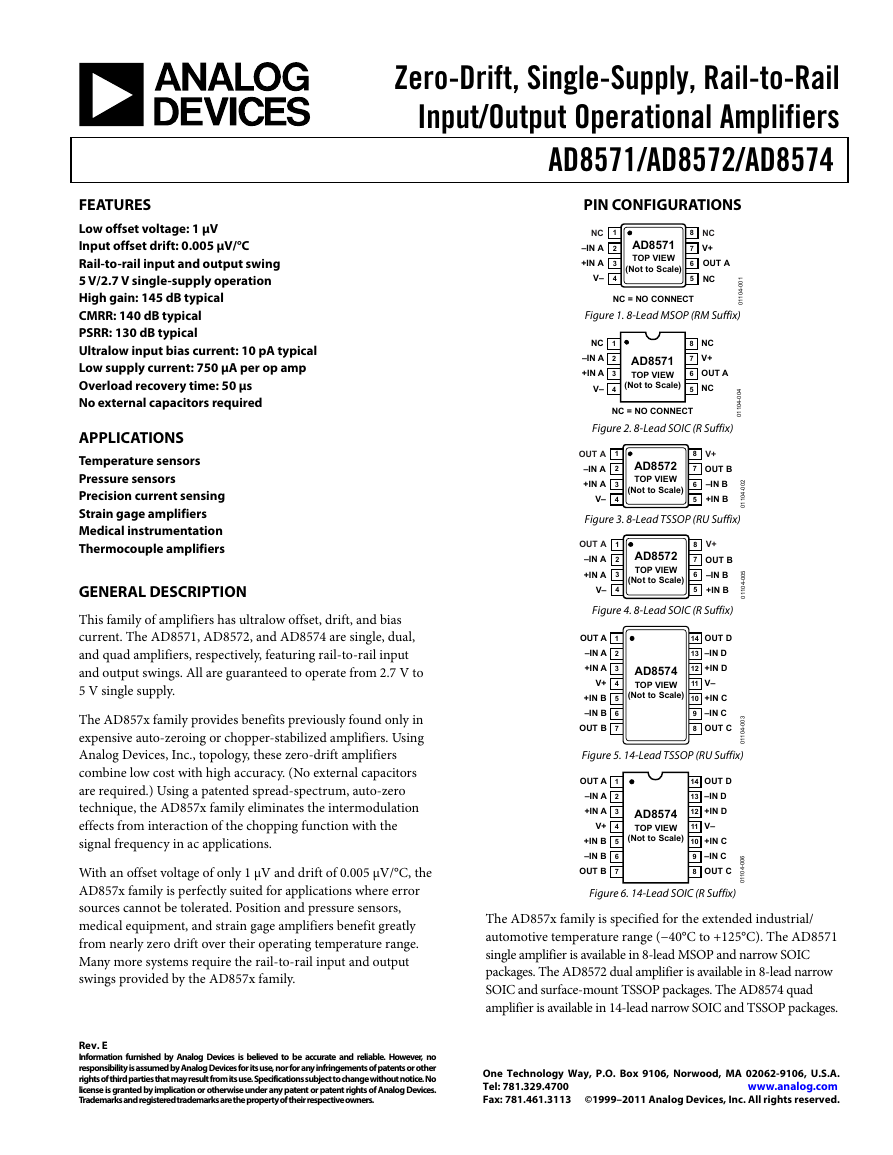
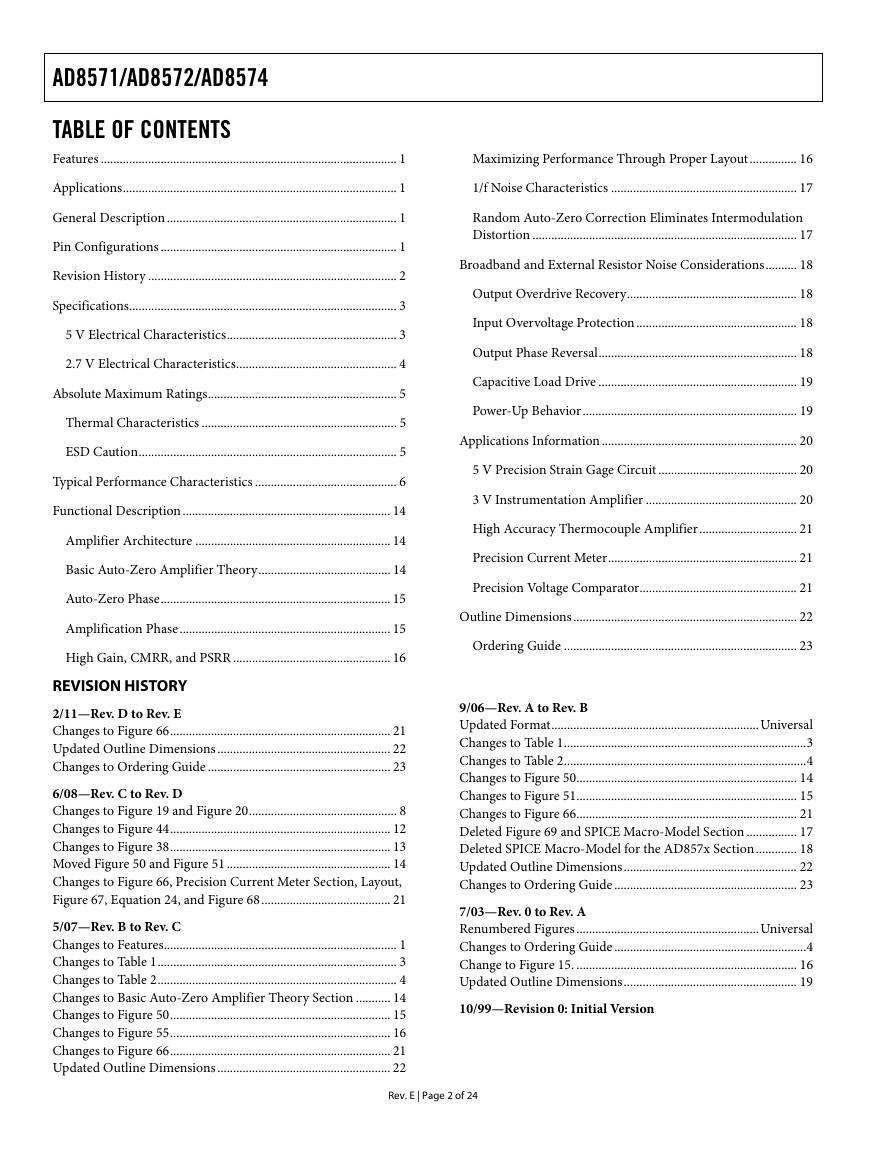
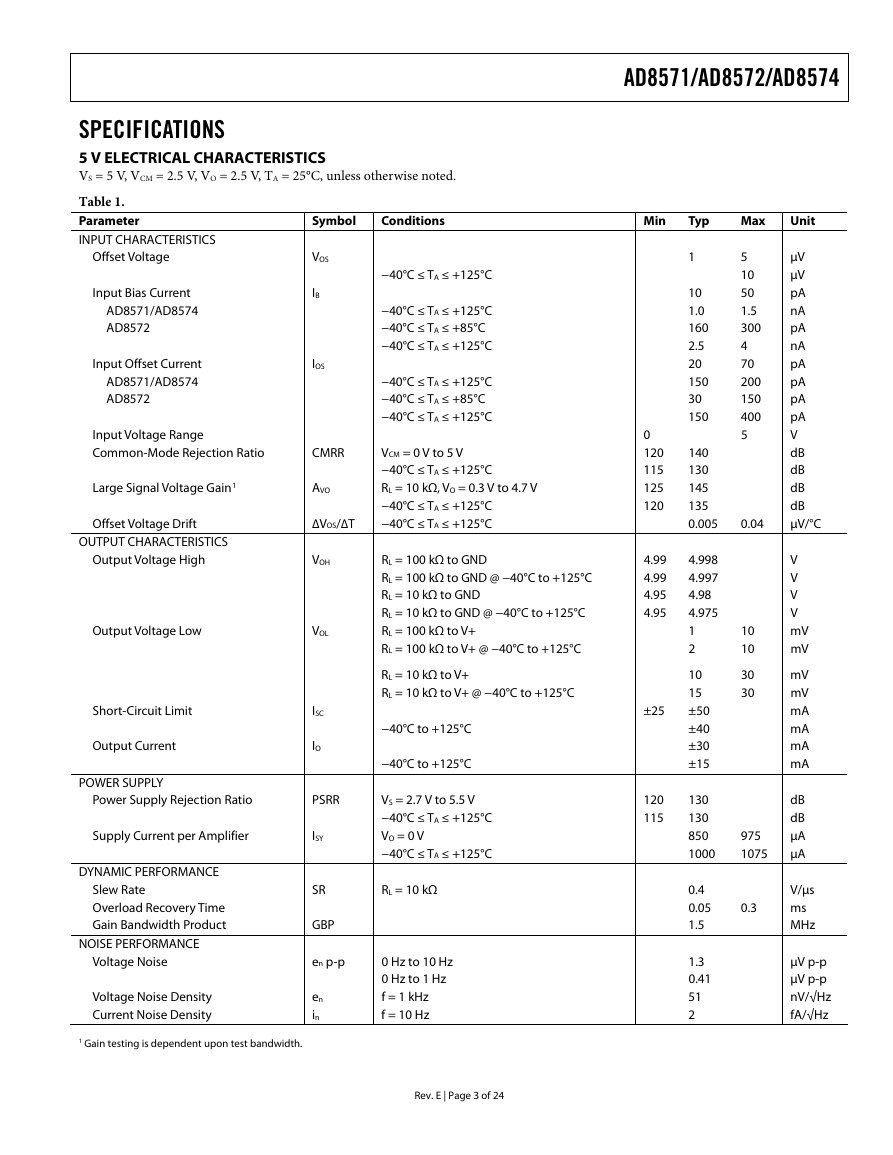
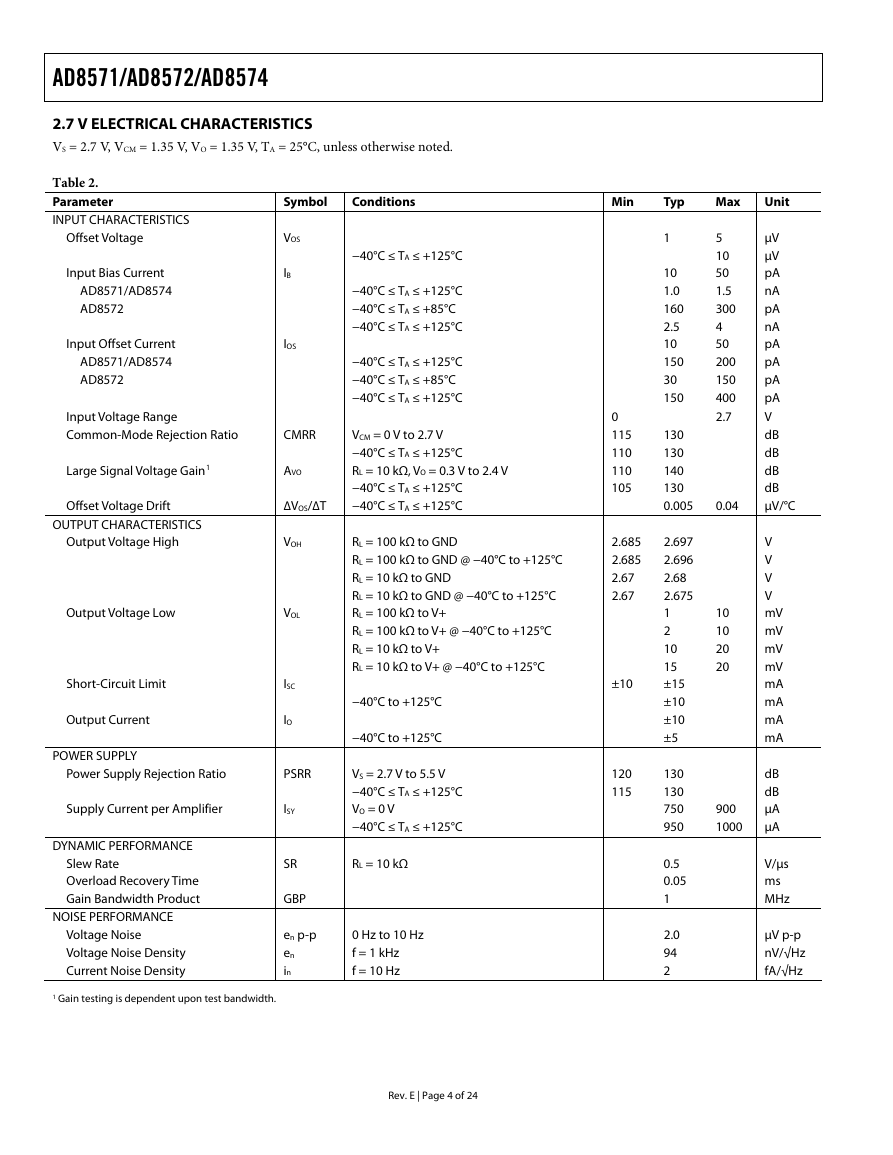
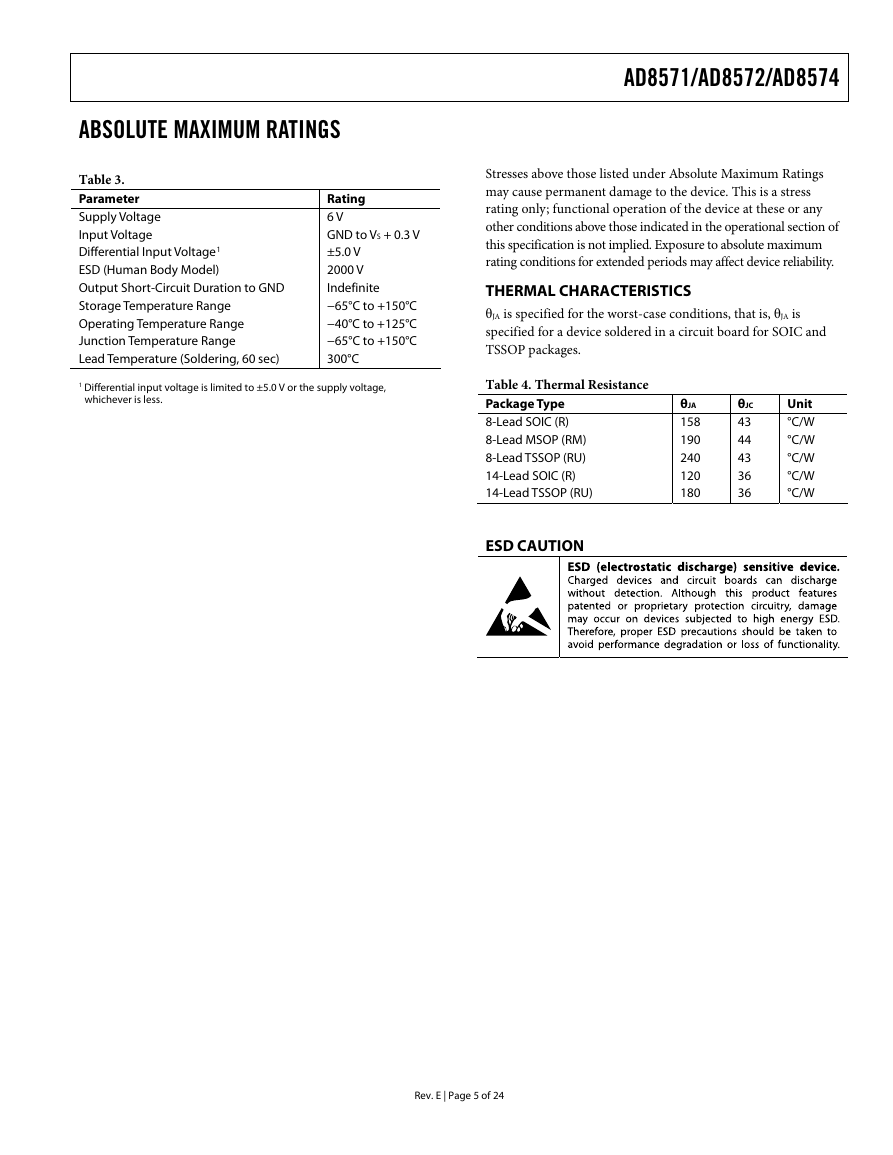
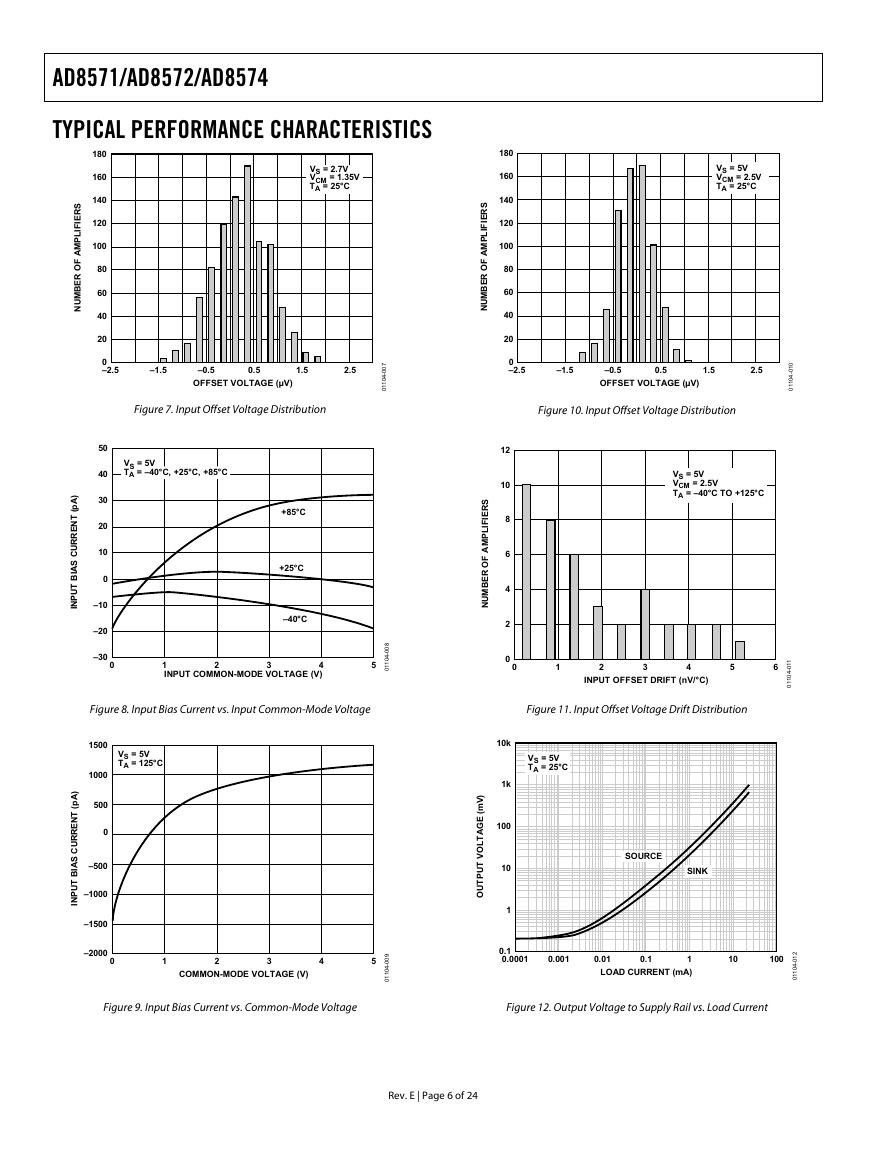
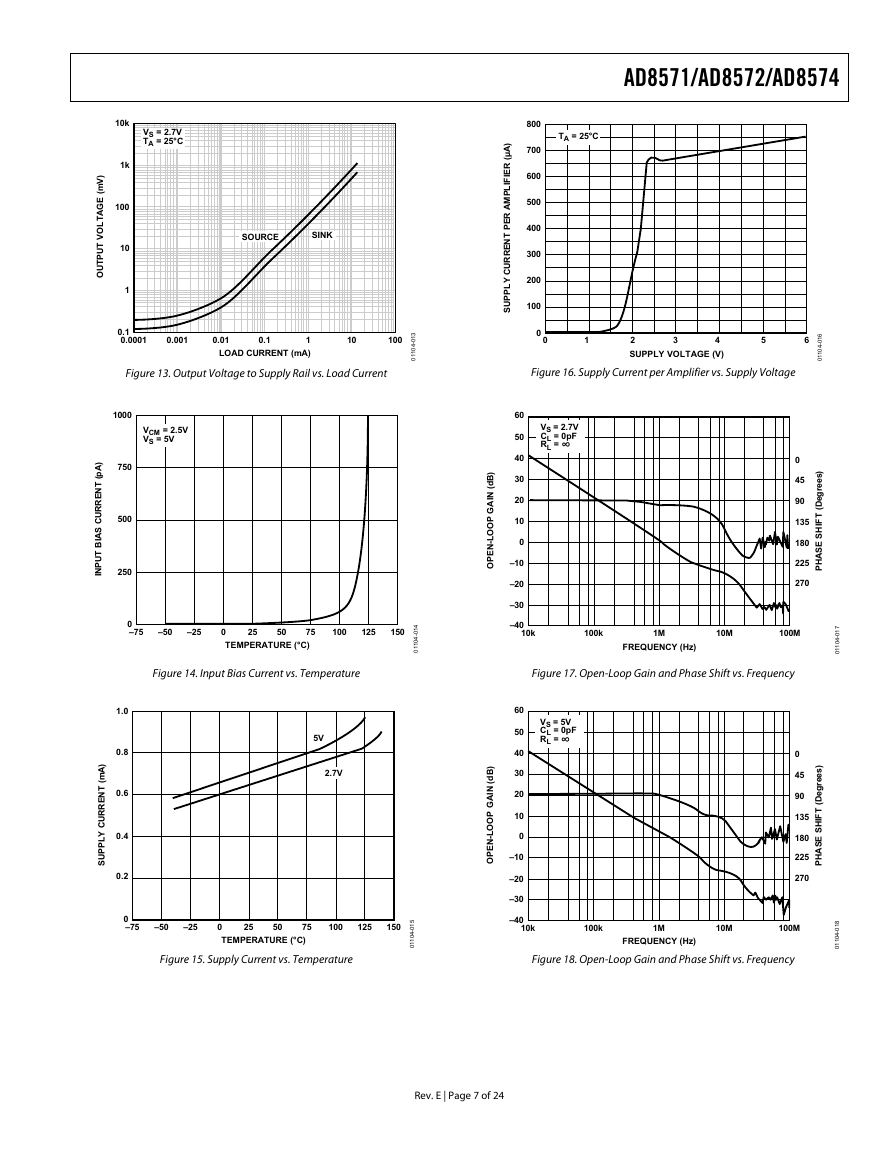
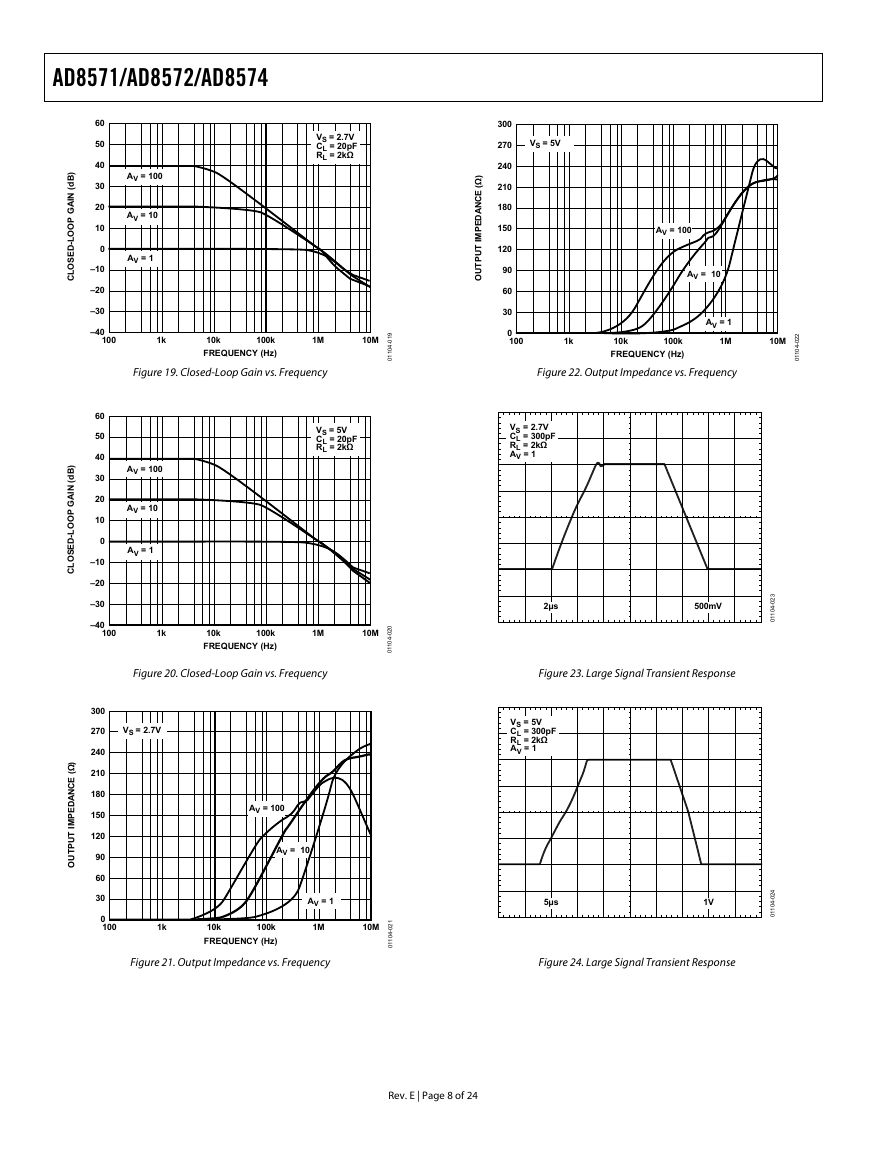








 2023年江西萍乡中考道德与法治真题及答案.doc
2023年江西萍乡中考道德与法治真题及答案.doc 2012年重庆南川中考生物真题及答案.doc
2012年重庆南川中考生物真题及答案.doc 2013年江西师范大学地理学综合及文艺理论基础考研真题.doc
2013年江西师范大学地理学综合及文艺理论基础考研真题.doc 2020年四川甘孜小升初语文真题及答案I卷.doc
2020年四川甘孜小升初语文真题及答案I卷.doc 2020年注册岩土工程师专业基础考试真题及答案.doc
2020年注册岩土工程师专业基础考试真题及答案.doc 2023-2024学年福建省厦门市九年级上学期数学月考试题及答案.doc
2023-2024学年福建省厦门市九年级上学期数学月考试题及答案.doc 2021-2022学年辽宁省沈阳市大东区九年级上学期语文期末试题及答案.doc
2021-2022学年辽宁省沈阳市大东区九年级上学期语文期末试题及答案.doc 2022-2023学年北京东城区初三第一学期物理期末试卷及答案.doc
2022-2023学年北京东城区初三第一学期物理期末试卷及答案.doc 2018上半年江西教师资格初中地理学科知识与教学能力真题及答案.doc
2018上半年江西教师资格初中地理学科知识与教学能力真题及答案.doc 2012年河北国家公务员申论考试真题及答案-省级.doc
2012年河北国家公务员申论考试真题及答案-省级.doc 2020-2021学年江苏省扬州市江都区邵樊片九年级上学期数学第一次质量检测试题及答案.doc
2020-2021学年江苏省扬州市江都区邵樊片九年级上学期数学第一次质量检测试题及答案.doc 2022下半年黑龙江教师资格证中学综合素质真题及答案.doc
2022下半年黑龙江教师资格证中学综合素质真题及答案.doc